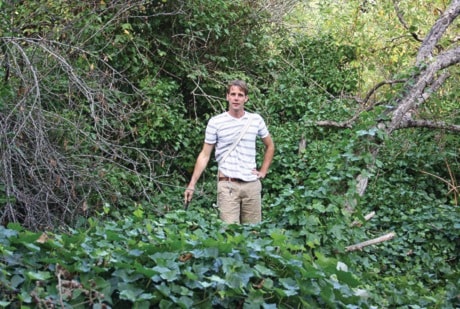Ben Clinton-Baker is passionate about history. He is currently completing a masters thesis in history at the University of Victoria and in 2002 he travelled to the United Kingdom in search of his own family history, a quest that led him as far back as the 1800s and then beyond to his family’s roots in the Norman settlements of Great Britain.
“I didn’t quite find any royalty in my family tree, but it was close,” says Clinton-Baker with a smile. “I wanted to know where I came from, how my family came to the British colony on Vancouver Island from the UK. It was a search for my own roots.”
Roots are very important to Clinton-Baker, in fact that’s the name of his upcoming exhibit at the Oak Bay Municipal Hall. The ‘Roots’ exhibit is comprised of a series of archival photos, explanatory text panels and representative artifacts of a bygone agricultural period in Oak Bay.
While many of the photos are from the Oak Bay Archives, some have come from private collections. “It’s amazing what people have out there. These records of the past are priceless. … They truly represent our heritage.”
Clinton-Baker has worked tirelessly to help preserve that heritage in other ways as well. He is a member of both the Oak Bay Heritage Commission and the Heritage Foundation.
The Heritage Foundation serves to promote the preservation of not just the bricks and mortar of significant heritage buildings but extends its mandate to the cultural and natural heritage of the area as well. It even makes some funding available for a portion of conservation work expenses.
The commission is a body appointed by the municipal council and advises on heritage and archive management issues.
“My interest in Oak Bay’s heritage was really sparked by conversations that I had with my grandfather about what the municipality was like when he was a boy,” says Clinton-Baker. “He was born and raised here and he remembers walking from Cadboro Bay Road to Willows Beach and crossing nothing but open fields of farmland.”
Things have changed since then, but his grandfather’s stories had an impact. “My grandfather inspired me,” says Clinton-Baker. “It’s not that he’s necessarily nostalgic for those times, but he gave me an appreciation of the value of knowing our history. He taught me that heritage is a fundamental pillar of the community – any community for that matter.”
It’s a lesson that Clinton-Baker has taken to heart and one that he is trying to instill in others. “It’s important that we discover and appreciate the heritage sites that remain,” he says. “Sometimes we can have something right in front of us without having an appreciation of its significance.”
An example of that lack of knowledge can be found in Uplands Park. Clinton-Baker discovered the foundation of the original Hudson’s Bay Company buildings, hidden and overgrown in an area near Dorset Avenue. “People walk within a hundred yards of this site and have no idea of what once stood here,” he says.
“That’s why I put the Roots exhibit together. It’s important that people have that sense of where they came from.”
“Even the plants within Uplands Park have a history,” says Clinton-Baker. “Every year we have the Friends of Uplands Park clearing out invasive plant species that were brought here by European settlers without a thought to how it would impact the natural environment. Now we’re dealing with the actions of those original settlers. … trying to restore and maintain the original, natural beauty of this area. Heritage preservation isn’t just about buildings.”
While the Roots exhibit deals primarily with the European-style agriculture of Oak Bay’s past, Clinton-Baker is also keenly aware of the First Nation populations that inhabited the area prior to European settlement. “The original inhabitants here had cultivated and maintained a shrub free grassland for centuries to enhance the growth of camas, a food crop for them. But the European settlers just considered it to be an ideal place to start their farms. In a way, the camas meadows determined where the settlement would be. Now we have some people who maintain that the original aboriginal occupants of the land had no agriculture. The meadows tell you they’re wrong.”
Clinton-Baker wishes that he had photos of those original meadows, but in the absence of those photos he will be including First Nations agriculture in the oral presentation he is giving at the Windsor Park Pavilion on Sept. 19 at 7 p.m. The speech will augment the Roots exhibit and will provide more detail on the area’s agricultural history.
“In the end, we build our future on the foundation of the past. Without strong roots in the past, we’ll never bear fruit in the future,” says Clinton-Baker.
Further information on Oak Bay’s archives can be found at heritageoakbay.ca.
